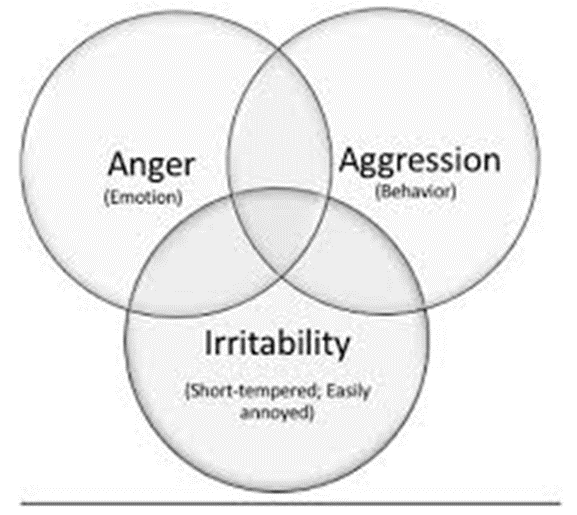An inpatient client who has a known history of violence suddenly begins to pace. Which additional client behavior should alert the nurse to escalating anger and aggression? The client:
Sits in group with back to peers.
Has a tense facial expression and body language.
Requests PRN medications.
Does not want to eat lunch.
The Correct Answer is B
Choice A Reason: Sits in group with back to peers
Sitting with one’s back to peers can indicate a desire for isolation or a lack of trust, but it is not a definitive sign of escalating anger or aggression. This behavior might be more indicative of withdrawal or discomfort in social settings rather than an immediate precursor to violence.
Choice B Reason: Has a tense facial expression and body language
This is the correct answer. Tense facial expressions and body language are clear indicators of escalating anger and aggression. Signs such as clenched fists, a rigid posture, and a furrowed brow are physical manifestations of internal tension and can precede aggressive outbursts. Recognizing these non-verbal cues is crucial for early intervention and de-escalation.

Choice C Reason: Requests PRN medications
Requesting PRN (as needed) medications can be a sign that the client is experiencing increased anxiety or distress. However, this behavior alone does not necessarily indicate escalating aggression. It may actually be a positive sign that the client is seeking help to manage their symptoms before they escalate.
Choice D Reason: Does not want to eat lunch
A lack of appetite or refusal to eat can be associated with various conditions, including depression, anxiety, or physical illness. While it may indicate that the client is not feeling well, it is not a specific indicator of escalating anger or aggression.
Nursing Test Bank
Naxlex Comprehensive Predictor Exams
Related Questions
Correct Answer is ["A","B"]
Explanation
The correct answer is a, b.
Choice A Reason:
The statement “Organize clinical observations” is correct. One of the primary functions of the Mental Status Exam (MSE) is to systematically organize clinical observations. This includes assessing the client’s appearance, behavior, mood, and cognitive functions. By organizing these observations, healthcare providers can create a comprehensive picture of the client’s current mental state, which is crucial for diagnosis and treatment planning.
Choice B Reason:
The statement “Obtain information about the client’s medical history” is correct. The MSE often involves gathering detailed information about the client’s medical history, including past mental health issues, treatments, and any relevant medical conditions. This information helps in understanding the client’s baseline mental status and identifying any changes or abnormalities. It also aids in creating an effective treatment plan tailored to the client’s specific needs.
Choice C Reason:
The statement “Establish limit setting” is incorrect. While limit setting is an important aspect of managing certain mental health conditions, it is not a primary function of the MSE. Limit setting typically involves establishing boundaries and rules to manage behaviors, which is more relevant in therapeutic settings rather than during the assessment phase. The MSE focuses on evaluating the client’s current mental state rather than setting behavioral limits.
Choice D Reason:
The statement “Determine the client’s IQ” is incorrect. The MSE is not designed to measure a client’s intelligence quotient (IQ)4. Instead, it assesses cognitive functions such as memory, attention, and orientation. IQ tests are specialized assessments that require specific tools and are conducted separately from the MSE. The MSE provides a general overview of cognitive functioning but does not quantify intelligence.
Correct Answer is A
Explanation
Choice A Reason:
Confirming boundaries by setting limits on behavior.
This response is correct because it directly addresses the need to set clear boundaries with the client. In a psychiatric setting, it is crucial to establish and maintain professional boundaries to ensure a therapeutic environment. By limiting the client’s approach to the nurse’s station, the nurse is setting a clear boundary that helps manage the client’s behavior and ensures that the nurse can attend to other patients as well. This intervention helps in maintaining structure and predictability, which can be very beneficial for clients with psychiatric conditions.
Choice B Reason:
Providing reality orientation.
Providing reality orientation involves helping clients understand their surroundings and current situation, often used for clients with cognitive impairments or disorientation. While important, this intervention does not specifically address the behavior of frequently approaching the nurse’s station. Reality orientation would be more relevant in cases where the client is confused about time, place, or person.
Choice C Reason:
Providing client education in a direct manner.
Providing client education is essential, but it does not directly relate to setting behavioral limits. Education might involve explaining the reasons behind certain rules or treatments, but it does not address the immediate need to manage the client’s frequent requests. The intervention described in the question is more about behavior management than education.
Choice D Reason:
Ensuring physical need fulfillment.
Ensuring physical need fulfillment involves addressing the client’s basic needs such as food, hydration, and comfort. While this is a fundamental aspect of nursing care, it does not relate to setting behavioral limits or managing the frequency of the client’s requests. The intervention in the question is focused on managing behavior rather than fulfilling physical needs.
Whether you are a student looking to ace your exams or a practicing nurse seeking to enhance your expertise , our nursing education contents will empower you with the confidence and competence to make a difference in the lives of patients and become a respected leader in the healthcare field.
Visit Naxlex, invest in your future and unlock endless possibilities with our unparalleled nursing education contents today
Report Wrong Answer on the Current Question
Do you disagree with the answer? If yes, what is your expected answer? Explain.
Kindly be descriptive with the issue you are facing.
